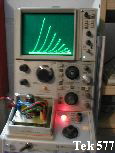Tube Testing & Repair Hints
Nowadays it isnīt easy to perform accurate, in the
meaning of time varying voltages, measurements, because in the lack of
suitable and affordable test gear. At the surplus markets you could get
lot of tube-testers, which means you apply a static voltages and then
read a plate current on an antique ammeter. Mostly the testers come
with an incredible amount and types of sockets you never need.
In my point of view it is more convenient to have only one tester, but
suitable for nearly all components that comes with a scope: resistors,
vdrīs, diodes, tunnel diodes (..!), backward- , snap-off-diodes and not
to forget zeners. Certainly you need to check all active devices like
transistors (germanium, silicon) and *tubes*.
The last industry-proven tube tester was the Tek 570
Electron-Tube-Curve Tracer.
This device plots all important characteristics on a 5-inch crt like
plate current against plate voltage, with the grid as parameter and
others. The 570 had in addition a built-in voltmeter and was
capable to hold and measure two tubes to match them...
 A year ago I had the opportunity
to buy a modern Tek 577 Curve Tracer with the storage capability. I
have only the adaptors for diodes and small-signal
transistors. After recalibration the 577 shows very good results.
I like especially the storage capablility so you can verifiy old
“temperature compensated zeners”. (Please donīt think in this case at
LTC burried-zener)
A year ago I had the opportunity
to buy a modern Tek 577 Curve Tracer with the storage capability. I
have only the adaptors for diodes and small-signal
transistors. After recalibration the 577 shows very good results.
I like especially the storage capablility so you can verifiy old
“temperature compensated zeners”. (Please donīt think in this case at
LTC burried-zener)
| [Entry] |
| [Plug-Ins] |
| [Timeline] |
| [Repair Hints] |
| [500 Scopes ] |
| [Generators] |